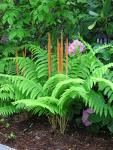
The fronds (“leaves” of a fern) emerge as fiddleheads (see picture) that are fuzzy and silvery green. These fiddle heads are very interesting and endearing to a fern lover like myself and to ruffled grouse who find them very tasty. The fertile fiddleheads become stiff and erect bearing spores that turn brown, giving the fern its common name. The sterile fiddleheads form a vase shaped circle of green leafy fronds around the fertile fronds. The contrast between the very upright, cinnamon colored fronds, and the green leafy sterile fronds make the fern a focal point in a woodland garden.
 As a bonus, the fiddleheads can be steamed or boiled and eaten. In addition, the ferns provide valuable shelter for many woodland birds and other wild life. Humming birds use the fuzz on the stipe (“stem”) of the fronds to line their nests .
As a bonus, the fiddleheads can be steamed or boiled and eaten. In addition, the ferns provide valuable shelter for many woodland birds and other wild life. Humming birds use the fuzz on the stipe (“stem”) of the fronds to line their nests .
Type: Deciduous fern.
Bloom: None.
Size: 3’-5’ H x 2’-3’ W.
Light: Part shade to shade but will tolerate sun if moisture abundant. Can grow in swamp, bog, or at edge of a stream.
Soil: Rich, moist, acidic (pH 4.5-7) humus ideal but tolerates less. Incorporate at least 50% organic matter (peat moss or compost) when planting.
Fertilizer: Organic mulch will provide needed nutrients so don’t use garden fertilizer.
Hardiness: Zones 3-9.
Care: Water 3-4 times a week after planting and frequently the first season and do so during dry spells in subsequent years.
Pests and Diseases: None of importance.
Propagation: Spreads slowly but very long lived; rhizomes can be divided in fall or spring but the plant may take a long time to recover after division; spores as soon as they ripen in mid to late summer.
Companion plants: Other woodland plants such as hellebores, bleeding hearts, Tiarella, Solomon’s Seal, Jack in the Pulpits, other ferns, and hostas.
